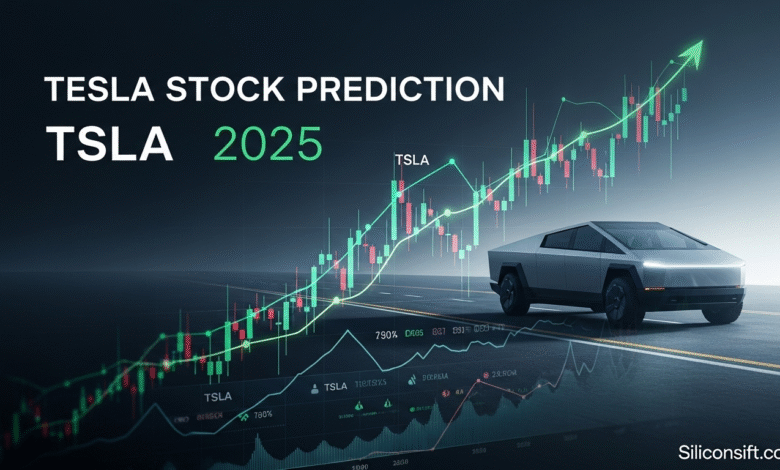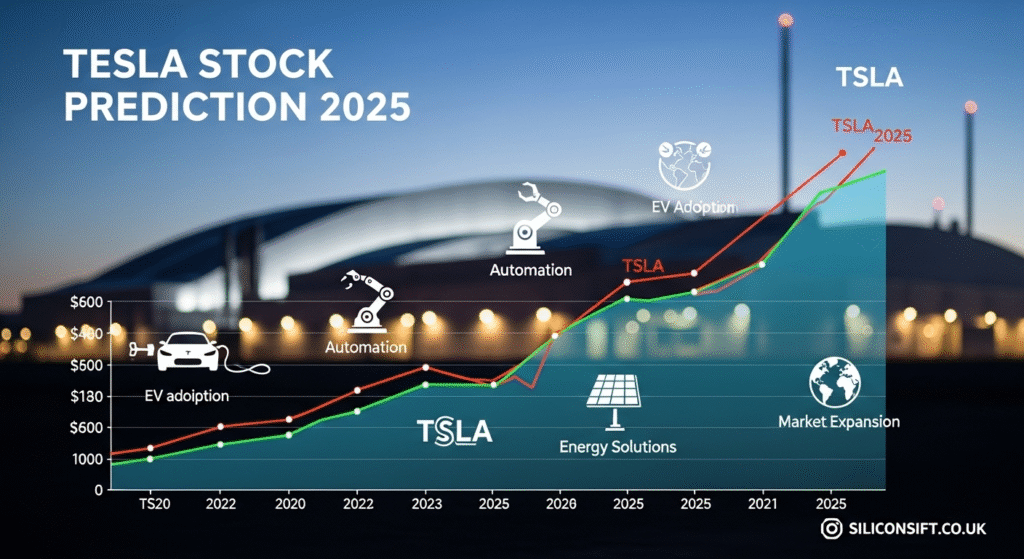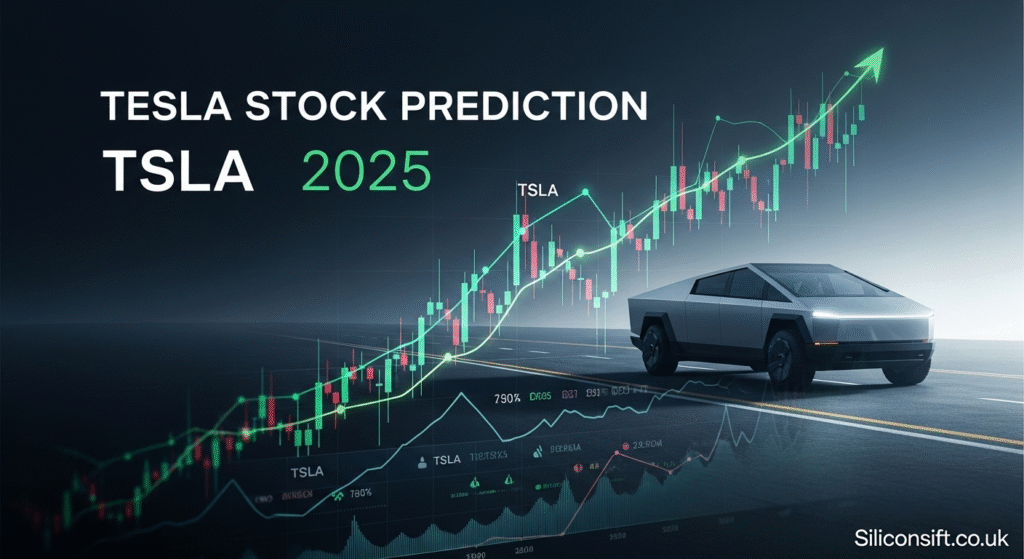Tesla Stock Prediction 2025: Bold Forecasts, Real Risks, and Smart Moves

Introduction
Tesla has always been more than just a car company. It’s a phenomenon that divides Wall Street like few other stocks can. Some investors see Elon Musk’s empire as the future of transportation and energy. Others worry about overvaluation and mounting competition. If you’re wondering where Tesla stock might land in 2025, you’re not alone. Millions of investors are asking the same question right now.
The Tesla stock prediction 2025 conversation has heated up significantly as we move deeper into the year. With artificial intelligence ambitions, robotaxi dreams, and traditional auto giants catching up in the electric vehicle race, the stakes have never been higher. This article breaks down what analysts are saying, which factors could move the needle, and what you should consider before making any investment decisions. Whether you’re a Tesla bull or a cautious skeptic, understanding the full picture helps you navigate this volatile stock more wisely.
Where Tesla Stock Stands Right Now
Tesla entered 2025 with a market capitalization that still places it among the world’s most valuable companies. The stock has experienced wild swings over the past few years. You’ve probably noticed that Tesla can gain or lose 5% in a single day without anyone batting an eye anymore. This volatility reflects both the company’s potential and the uncertainty surrounding its future.
The current valuation raises important questions. Tesla trades at price-to-earnings ratios that traditional automakers can only dream about. This premium pricing assumes massive growth ahead. Investors aren’t just betting on more car sales. They’re betting on full self-driving technology, energy storage dominance, and potential breakthroughs in robotics.
Recent quarterly earnings have shown mixed signals. Vehicle deliveries sometimes miss analyst expectations. Profit margins face pressure from price cuts. Yet Tesla maintains strong cash flow and continues expanding production capacity. The company operates massive factories across multiple continents. This global footprint provides both opportunities and challenges as different markets evolve at different speeds.
What Analysts Are Saying About Tesla Stock in 2025
Wall Street analysts remain deeply divided on Tesla stock prediction 2025 scenarios. Some major investment firms have price targets suggesting significant upside from current levels. Others have issued cautious or even bearish calls. This split opinion creates the volatility you see in daily trading.
Bullish analysts typically point to several factors. They believe Tesla’s lead in battery technology and manufacturing efficiency will protect market share. They expect autonomous driving to eventually unlock massive new revenue streams. Some even model scenarios where Tesla becomes a dominant player in energy storage and generation. These optimistic forecasts sometimes place Tesla stock above $400 or even $500 per share by year end.
Bearish analysts focus on different concerns. Traditional automakers have invested billions in electric vehicles. Competition has intensified globally, especially from Chinese manufacturers. Profit margins are shrinking as Tesla cuts prices to maintain volume. Regulatory challenges around full self-driving technology could delay or limit the robotaxi vision. These skeptics sometimes suggest Tesla could trade below $150 if reality fails to meet expectations.
The average analyst price target typically falls somewhere in the middle. Most major banks project modest gains or losses from current levels. This middle-ground view suggests Tesla might trade in a range rather than make dramatic moves in either direction. However, average targets can be misleading when the range of opinions is so wide.

Key Factors That Will Shape Tesla’s 2025 Performance
Several critical elements will determine whether Tesla stock rises or falls throughout 2025. Understanding these factors helps you make more informed decisions about this complex investment.
Electric Vehicle Demand and Market Share
Global EV adoption continues growing, but the pace varies by region. China remains the world’s largest EV market. Europe maintains strong environmental policies supporting electric vehicles. The United States market is expanding, though political winds can shift incentive structures. Tesla must maintain or grow its slice of this expanding pie while facing tougher competition than ever before.
Price wars have emerged across major markets. Tesla has repeatedly adjusted pricing to stimulate demand. Lower prices can boost volume but squeeze margins. Competitors from BYD to Ford are fighting for the same customers. Your investment outcome partly depends on whether Tesla can defend its premium brand position or becomes just another car company competing on price.
Full Self-Driving and Robotaxi Ambitions
Elon Musk has promised that Tesla vehicles will achieve full autonomous driving capability. The company has been collecting real-world driving data for years. This data advantage could prove decisive if Tesla cracks the self-driving puzzle. The robotaxi concept envisions Tesla owners earning money by letting their cars provide autonomous ride-sharing services.
However, regulatory approval remains uncertain. Full self-driving technology must prove safer than human drivers. Governments move slowly on such critical safety issues. Liability questions remain unresolved. The timeline for widespread robotaxi deployment could easily stretch beyond 2025. This uncertainty makes it difficult to assign concrete value to this potential revenue stream.
Energy Storage and Solar Business
Tesla’s energy division gets less attention than its car business, but it’s growing rapidly. Large-scale battery installations help utilities manage renewable energy. Home battery systems provide backup power and energy independence. This business carries higher margins than vehicle sales. Successful expansion here could meaningfully boost overall profitability.
The global push for renewable energy creates tailwinds for this division. Governments are investing in grid modernization. Businesses need energy storage to manage costs. Tesla has strong technology and brand recognition in this space. If this division significantly outperforms expectations, it could justify higher valuations even if car sales disappoint.
Economic Conditions and Interest Rates
Broader economic factors affect Tesla differently than defensive stocks. Higher interest rates make expensive vehicles less affordable. They also make future profits less valuable when discounted to present value. Economic uncertainty can depress consumer spending on big-ticket items. You need to consider the macroeconomic environment when evaluating Tesla Stock Prediction 2025 scenarios.
Conversely, lower rates and strong economic growth benefit Tesla. Consumers feel more confident making large purchases. Stock valuations tend to expand in low-rate environments. The Federal Reserve’s monetary policy decisions throughout 2025 will create headwinds or tailwinds for growth stocks like Tesla.
Elon Musk Factor
Love him or hate him, Elon Musk moves Tesla’s stock. His tweets can add or subtract billions in market cap. His other ventures, particularly X (formerly Twitter) and SpaceX, sometimes distract from Tesla. Some investors worry about key-person risk if something happened to Musk. Others believe his vision and execution make Tesla impossible to replicate.
Musk’s public statements about politics, social issues, and other companies have alienated some potential customers. Brand perception matters in consumer goods. Tesla’s brand strength partially depends on how the public views its CEO. This intangible factor is hard to quantify but undeniably important for stock performance.
Bull Case: Why Tesla Could Soar in 2025
Let’s explore the optimistic scenario. If several things go right, Tesla stock could deliver substantial returns this year. Understanding this case helps you recognize what would need to happen for bulls to be correct.
Imagine Tesla successfully launches a more affordable vehicle model. This could unlock massive demand from price-sensitive buyers. Lower production costs could maintain healthy margins even at lower price points. Vehicle deliveries could significantly exceed current expectations. Higher volume at decent margins would boost earnings and potentially justify higher valuations.
Suppose full self-driving technology achieves a major breakthrough. Regulatory approval in one or more major markets would validate years of development. The robotaxi network could begin generating revenue. Even small initial revenues from autonomous services would excite investors about future potential. This scenario could add tens of billions to Tesla’s market cap.
Tesla’s energy business might accelerate faster than expected. Major utility contracts could multiply. Home battery adoption could reach an inflection point. This high-margin business growing rapidly would improve the overall financial profile. Investors might start valuing Tesla as much for energy as for vehicles.
Macroeconomic conditions could turn favorable. Interest rate cuts would reduce financing costs for customers. Strong economic growth would boost consumer confidence. These tailwinds would benefit Tesla disproportionately compared to traditional automakers. The growth stock premium would expand in a risk-on environment.
Bear Case: Why Tesla Could Struggle in 2025
Now consider the pessimistic scenario. If key risks materialize, Tesla stock could decline significantly. Understanding these dangers helps you assess downside potential.
Competition could intensify beyond current expectations. Chinese EV makers might aggressively expand internationally. Traditional automakers could release compelling electric models that steal market share. Tesla might lose its technology advantage as others catch up. Market share erosion would force continued price cuts and margin compression.
Full self-driving could hit major setbacks. A serious accident involving Tesla’s autonomous features might trigger regulatory crackdowns. Technical challenges could prove harder than expected. The robotaxi timeline might push out to 2027 or beyond. Investors who’ve assigned value to this potential would need to reassess.
Economic conditions might deteriorate. A recession would crush demand for expensive vehicles. Rising unemployment would make financing difficult for potential buyers. Higher interest rates could persist longer than expected. Tesla’s high valuation multiple would contract in a risk-off environment.
Execution issues could emerge. Manufacturing problems might constrain production. Quality concerns could damage brand reputation. Key executives could leave the company. Any operational stumbles would get punished harshly given current valuation expectations.
How to Think About Investing in Tesla Stock
Tesla stock prediction 2025 analysis ultimately must translate into practical investment decisions. How should you approach this controversial stock?
First, understand your own risk tolerance. Tesla is not a conservative investment. The stock can and does move dramatically. If you can’t stomach 20% or 30% drawdowns, Tesla might not fit your portfolio. Position sizing matters enormously. A small position lets you participate without excessive risk.
Second, separate the company from the stock. Tesla might be an excellent company while simultaneously being an overpriced stock. Valuation matters. You need to ask whether current prices already reflect optimistic scenarios. Buying expensive stocks requires everything going right just to achieve average returns.
Third, consider your time horizon. Short-term Tesla stock movements are essentially unpredictable. Catalysts can emerge from nowhere. Elon Musk can tweet something market-moving at any moment. Long-term investors have more time for the thesis to play out. If you believe in the multi-year story, short-term volatility matters less.
Fourth, diversification remains crucial. Even if you love Tesla, it shouldn’t dominate your portfolio. No single stock should. Concentrated positions in volatile stocks create unnecessary risk. You can believe in Tesla’s future while still maintaining a balanced portfolio.
Alternative Ways to Gain Tesla Exposure
You don’t have to buy individual shares to gain Tesla exposure. Several alternatives exist for different investment styles and risk profiles.
Many growth-oriented ETFs hold significant Tesla positions. These funds provide built-in diversification while maintaining exposure to your target company. The reduced volatility might help you sleep better at night. However, you’ll also own dozens or hundreds of other companies.
Options strategies offer sophisticated approaches. Covered calls can generate income if you already own shares. Cash-secured puts let you potentially buy shares at lower prices while collecting premium. Long-dated call options provide leveraged upside exposure. These strategies require more knowledge and active management.
Some investors prefer waiting for better entry points. Tesla stock has historically offered opportunities to buy at meaningfully lower prices. Patient investors can set price targets and wait. This discipline prevents chasing momentum and buying at emotional highs.
What Could Surprise Everyone in 2025
Sometimes the most important developments are the ones nobody sees coming. Tesla operates in rapidly evolving industries where surprises happen regularly.
A major partnership could emerge unexpectedly. Tesla might license its self-driving technology to other manufacturers. A deal with a major ridesharing platform could accelerate robotaxi deployment. Strategic alliances could unlock value in ways current analysis misses.
New product announcements could shift the narrative. Tesla has historically kept new models under wraps until dramatic reveals. A breakthrough in battery technology could reset competitive dynamics. Products in adjacent markets could open new revenue streams.
Regulatory changes might occur faster than expected. Government mandates could accelerate EV adoption timelines. Autonomous vehicle frameworks could suddenly crystallize. International trade policies could shift in Tesla’s favor or against it.
Macroeconomic shocks could dominate all company-specific factors. Geopolitical events, financial crises, or unexpected policy changes can move entire markets. Tesla would ride those waves regardless of operational performance.

Conclusion
The Tesla stock prediction 2025 debate will continue throughout the year. No one knows with certainty where the stock will trade by December. The range of possibilities remains wide because Tesla faces both enormous opportunities and serious challenges.
You’ve seen the bull case built on technological leadership, market expansion, and new revenue streams. You’ve also seen the bear case built on competition, valuation concerns, and execution risks. Both scenarios have merit. The truth might land somewhere in between, or events could prove one side decisively correct.
Your investment decision should align with your financial goals, risk tolerance, and belief in Tesla’s long-term vision. This stock will remain volatile and controversial. Price swings will test your conviction. Make sure any Tesla position fits within a broader investment strategy.
What’s your take on Tesla’s prospects this year? Are you betting on continued innovation or worried about mounting challenges?
Frequently Asked Questions
What is the most realistic Tesla stock prediction for 2025?
Most analysts project Tesla stock trading between $180 and $350 by the end of 2025. The wide range reflects genuine uncertainty about key factors like competition, autonomous driving progress, and economic conditions. Conservative investors should plan for continued volatility rather than steady appreciation.
Will Tesla stock reach $500 in 2025?
Reaching $500 would require major positive catalysts and significant multiple expansion from current levels. Full self-driving breakthroughs, explosive energy division growth, or dramatically better vehicle margins could theoretically drive such gains. However, most analysts consider this scenario unlikely within 2025’s timeframe.
Is Tesla stock a good buy right now?
Whether Tesla is a good buy depends on your investment goals and risk tolerance. Growth investors willing to accept volatility might find current prices attractive if they believe in long-term potential. Value-focused investors might prefer waiting for lower entry points. The stock trades at a premium valuation requiring strong execution to justify.
What could cause Tesla stock to crash in 2025?
Several factors could trigger significant declines. A recession reducing vehicle demand, major autonomous driving setbacks, intensifying competition eroding market share, or broader tech stock selloffs would pressure prices. Unexpected operational problems or key executive departures could also spark sharp declines.
How does Tesla compare to other EV stocks?
Tesla maintains advantages in brand recognition, charging infrastructure, and manufacturing scale. However, it trades at significantly higher valuations than competitors. Other EV makers offer more value-oriented entry points but lack Tesla’s integrated ecosystem. Chinese EV companies offer exposure to the world’s largest EV market at lower prices.
Should I hold Tesla stock long-term or trade it?
Long-term holding makes sense if you believe in Tesla’s multi-year vision and can tolerate volatility. Active trading requires significant time, skill, and emotional discipline. Most retail investors perform better with buy-and-hold strategies. Your tax situation also matters, as short-term capital gains carry higher rates.
What percentage of my portfolio should be in Tesla?
Financial advisors typically recommend limiting individual stock positions to 5% or less of your portfolio. Given Tesla’s volatility, even smaller positions make sense for conservative investors. Your age, financial goals, and risk tolerance should guide position sizing decisions.
When is the best time to buy Tesla stock in 2025?
Timing markets consistently is nearly impossible. Dollar-cost averaging, where you invest fixed amounts regularly, removes timing decisions and reduces risk. Buying during broad market selloffs or after disappointing earnings can offer better entry points if you have patience to wait.
How do interest rates affect Tesla stock?
Higher interest rates increase vehicle financing costs, reducing demand. They also make future profits less valuable in present value terms, compressing growth stock multiples. Lower rates have opposite effects, generally benefiting Tesla. The Federal Reserve’s policy decisions throughout 2025 will meaningfully impact Tesla’s valuation.
What makes Tesla different from traditional car companies?
Tesla focuses on vertical integration, controlling everything from battery production to software. Traditional automakers rely more on supplier networks. Tesla’s direct-to-consumer sales model differs from dealer networks. The company invests heavily in autonomous driving and energy storage, areas where traditional manufacturers are less aggressive. These differences justify valuation premiums but also create execution challenges.
Also Read siliconsift.co.uk